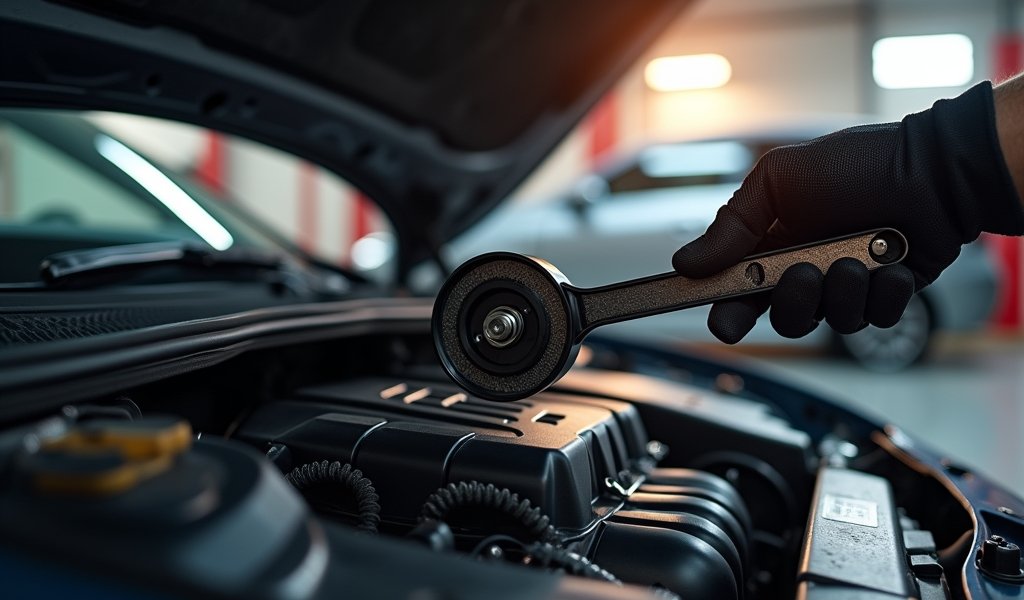Overview
This article provides a complete guide to diagnosing and replacing an alternator belt tensioner, including signs of failure, required tools, step-by-step instructions, and maintenance tips. It emphasizes that this DIY repair can save $150-400 compared to professional service while preventing potential damage to other vehicle components and extending overall vehicle lifespan.
Table of Contents
- What is an Alternator Belt Tensioner?
- Signs You Need a Replacement
- Tools and Materials Needed
- Preparation Steps
- Safety Precautions
- Step-by-Step Replacement Guide
- Testing After Replacement
- Troubleshooting Common Issues
- Maintenance Tips
- Conclusion
- Frequently Asked Questions
What is an Alternator Belt Tensioner?
Ever wonder what keeps that serpentine belt running smoothly under your hood? That’s where the alternator belt tensioner comes in! 🔧 This nifty component is essentially the unsung hero of your engine’s belt system, maintaining just the right amount of tension on your serpentine belt (also called a drive belt).
Think of it as a mechanical stress manager. Too much tension, and your belt wears out prematurely. Too little, and it slips, causing that lovely morning screech that has your neighbors peeking through their blinds. The tensioner uses a spring-loaded pulley that automatically adjusts to keep things running smoothly as your belt naturally stretches over time.
Your tensioner plays a crucial role in powering several essential components of your vehicle, including the alternator (which charges your battery), power steering pump, air conditioning compressor, and sometimes the water pump. Without proper tension, these systems can fail, leaving you stranded or facing expensive repairs.
Signs You Need a Replacement
Your car has a way of letting you know when the tensioner is on its way out. Here are some telltale signs it’s time for an alternator belt tensioner replacement:
- Squealing or chirping noises, especially during startup or acceleration 🔊
- Visible belt damage like cracks, fraying, or a glazed appearance
- Battery warning light illuminating on your dashboard
- Belt slipping off the pulleys
- Unusual pulley movement or “wobbling” when the engine runs
- The tensioner arm doesn’t move smoothly when tested
- Accessories like power steering or A/C not functioning properly
If you’re experiencing two or more of these symptoms, don’t wait until you’re stranded with a dead battery or overheated engine. The good news is that this is a relatively straightforward DIY repair that can save you $150-400 compared to shop rates!

Tools and Materials Needed
Before diving into this project, let’s gather everything you’ll need. Having all your tools and parts ready will make this job much smoother! 🧰
Tools:
- Socket set and ratchet (check your vehicle manual for the specific size)
- Breaker bar for extra leverage
- Torque wrench
- Flashlight or work light (a headlamp works wonders)
- Pliers
- Safety glasses and gloves
- Your vehicle’s service manual or reliable online instructions
Parts:
- New belt tensioner (ensure exact fit for your vehicle make/model)
- New serpentine belt (recommended to replace while you’re at it)
- Any other worn components identified during inspection (idler pulleys, etc.)
For most vehicles, this job takes about 1-2 hours for someone with basic mechanical skills. The difficulty level is moderate – challenging enough to feel accomplished but not so difficult that you’ll question your life choices halfway through! 💪
Preparation Steps
A successful repair starts with proper preparation. Take these steps before touching a single bolt:
First, confirm you have the correct replacement part. Check your vehicle’s manual or use the old tensioner to match exactly. Parts stores can help with this, or you can find the part number using online resources like AutoZone’s belt tensioner guide.
Next, locate the tensioner on your engine. It’s typically mounted to the front of the engine block and connected to your serpentine belt. The location varies by vehicle, so consult your service manual if you’re having trouble finding it.
Take multiple photos of the belt routing from different angles. Trust me on this one – these photos will be lifesavers during reassembly! 📱 Even experienced mechanics do this because belt routing can be complex, and memory alone isn’t reliable when you’re staring at a pile of parts.
Clear your work area and make sure you have enough light. Nothing makes a simple job difficult like working in poor conditions. A good-quality flashlight or headlamp will make this job much easier.
Safety Precautions
Before we get our hands dirty, let’s talk safety. Even a seemingly simple car repair can turn dangerous without proper precautions:
- Ensure your engine is completely cool before starting. Working on a hot engine is a recipe for nasty burns.
- Disconnect the negative terminal of your battery to prevent electrical shorts or accidental engine starts.
- If you need to lift the vehicle, use proper jack stands – never rely solely on a jack.
- Work in a well-ventilated area to avoid inhaling harmful fumes.
- Wear safety glasses to protect your eyes from debris and gloves to protect your hands.
- Keep a fire extinguisher nearby, just in case.
Remember, no repair is worth risking your safety. If at any point you feel uncomfortable with the process, there’s no shame in seeking professional help. Your well-being is worth more than the money saved!

Step-by-Step Replacement Guide
Now for the main event – let’s replace that tensioner! I’ll break this down into manageable steps even if you’re a first-timer. 🔍
Step 1: Create Access
Depending on your vehicle, you might need to remove certain components to properly access the tensioner. Common obstacles include splash shields, cooling fans, and air intake components. Remove only what’s necessary, keeping track of all hardware and the order of disassembly.
Step 2: Relieve Belt Tension
Locate the tensioner pulley – it usually has a square or hexagonal hole for inserting your breaker bar or socket wrench. Insert your tool and rotate the tensioner in the direction that releases tension on the belt (usually clockwise, but check your manual). While maintaining pressure, slide the serpentine belt off one of the pulleys with your free hand. Then slowly release the tensioner.
Step 3: Remove the Old Tensioner
With the belt removed, you can now access the mounting bolts that secure the tensioner to the engine block. Remove these bolts carefully, keeping track of their positions. Gently extract the old tensioner, noting its orientation. Compare it with your replacement part to confirm they match exactly.
Step 4: Inspect Related Components
While you have access to this area, take a moment to inspect all pulleys for smooth rotation and proper alignment. Check for any signs of damage or wear on idler pulleys and other belt-driven components. This “while you’re in there” inspection can save you from repeating this job sooner than necessary!
Step 5: Install the New Tensioner
Position the new tensioner in the exact orientation as the old one. Hand-thread the mounting bolts to avoid cross-threading, then tighten them to the manufacturer’s specified torque using your torque wrench. This step is crucial – too loose and the tensioner can work free, too tight and you risk damaging threads or breaking components.
Step 6: Reinstall the Belt
Using your reference photos, route the belt around all pulleys except one. Use your breaker bar to rotate the tensioner again, creating enough slack to slip the belt over the final pulley. Double-check that the belt is properly seated in all grooves of all pulleys. Slowly release the tensioner, allowing it to apply proper pressure to the belt.
Pro tip: If you’re also replacing your timing belt, now might be a good time to check if you’re due for that service too, as you’ve already got many of the components accessible!
Testing After Replacement
After installation, it’s crucial to verify that everything is functioning correctly before hitting the road. 🚗 Don’t skip these important checks:
First, do a visual inspection. Verify that the belt is properly aligned on all pulleys with no visible twisting or misalignment. The belt should sit properly in each pulley groove.
Next, try a manual rotation test. With the engine off, try rotating the largest accessible pulley by hand. The belt should move all accessories without slipping or excessive resistance.
Now for the engine test: Reconnect your battery, start the engine, and listen carefully. The new tensioner should operate silently, and the belt should run smoothly without squealing or chirping.
Finally, turn off the engine after running it for 5-10 minutes, let it cool down, and re-inspect the tensioner and belt to ensure proper tension has been maintained and nothing has worked loose.
Troubleshooting Common Issues
Even with careful work, sometimes things don’t go perfectly. Here are solutions to common problems you might encounter:
Belt Still Squeals After Replacement
If you still hear squealing after replacement, check for:
- Incorrect belt routing (compare to your photos or diagrams)
- Belt contamination from oil or coolant leaks
- Seized or damaged accessory pulleys (they should spin freely by hand)
- Improper tensioner installation or incorrect part
Difficulty Achieving Proper Tension
If your belt seems too loose or too tight:
- Verify you have the correct tensioner for your specific vehicle
- Ensure the tensioner moves freely through its full range of motion
- Check that the tensioner spring is properly engaged
- Confirm you’re using the correct belt length
Clearance Problems
If components seem to be making contact:
- Double-check the tensioner orientation
- Verify all brackets and mounts are properly positioned
- Ensure no wiring harnesses are caught between components
According to Gates Corporation research, about 30% of belt system failures are actually due to related components like tensioners and idler pulleys, not the belt itself. Addressing these components proactively prevents cascading failures.
Maintenance Tips
To keep your new tensioner and belt system working properly for years to come:
- Inspect your belt visually every 3 months or 3,000 miles (look for cracks, fraying, or glazing)
- Listen for unusual noises when starting your engine
- Keep engine components clean and free of oil or fluid leaks (which can degrade the belt)
- Address any related issues promptly (like worn pulleys or bearings)
- Consider checking your timing belt replacement schedule and performing preventative maintenance according to manufacturer recommendations
A well-maintained belt system not only prevents breakdowns but also improves fuel efficiency and extends the life of connected components. Think of it as a small investment that pays big dividends in reliability! 💰
The automotive specialists at Consumer Reports note that preventative maintenance like this can extend vehicle lifespan by years and save thousands in emergency repair costs over the life of your vehicle.
Conclusion
Congratulations! You’ve successfully navigated the process of alternator belt tensioner replacement. 🎉 This DIY project not only saves you money but also gives you valuable insight into how your vehicle operates.
By tackling this repair yourself, you’ve likely saved between $150-$400 compared to shop rates, depending on your vehicle make and model. More importantly, you’ve prevented potential roadside emergencies and protected related systems from damage.
Remember that preventative maintenance is always more economical than emergency repairs. By addressing your tensioner before complete failure, you’ve protected your alternator, battery, and other belt-driven accessories from potential damage.
The skills and confidence you’ve gained through this project will serve you well in future maintenance tasks. Each DIY success builds your mechanical knowledge and helps you make better decisions about your vehicle’s care.
Keep your service records updated to track when this component was replaced, and you’ll be ready to enjoy miles of worry-free driving ahead!
Frequently Asked Questions
How long does an alternator belt tensioner typically last?
Most tensioners last between 60,000 to 100,000 miles, depending on driving conditions and vehicle make. Regular inspection can help catch problems before failure occurs.
Can I replace just the tensioner without replacing the belt?
While technically possible, it’s highly recommended to replace the belt when replacing the tensioner. Since you’ve already done the labor to access the components, installing a fresh belt is inexpensive insurance.
How much does it cost to replace an alternator belt tensioner professionally?
Professional replacement typically costs between $200-450 depending on your vehicle make, model, and location. The parts usually cost $50-150, with labor making up the remainder.
What happens if I drive with a bad tensioner?
A bad tensioner can lead to belt failure, which may cause overheating, battery discharge, loss of power steering, and potentially being stranded. It can also cause premature wear on other belt-driven components.
How do I know if I need just the tensioner or the entire tensioner assembly?
If the pulley spins freely without wobble but the spring tension feels weak, you might only need the tensioner. If the pulley is damaged, wobbles, or makes noise, replace the entire assembly.


Pingback: supercharger belt tensioner adjustment! - knowsyourcar.com